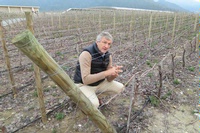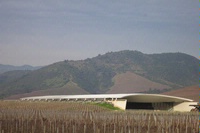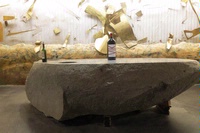|
|
 |
.jpg)
Alexander Vik had a dream: To create the best wine in South America. He is a citizen of Norway, graduate of Harvard, a successful entrepreneur who is included in Forbes’ world list of billionaires. He and his wife Carrie have built luxury resorts in Uruguay and Chile where their appreciation of art is on stylishly opulent display. Vik assembled an expert team of oenologists, climatologists, geologists, viticulturists and agronomists to find the ideal site in South America to produce his dream wine. They settled on a spot about two hours south of Santiago, across the mountains from Apalta, home of Montes and Casa Lapostolle. It was nearly 11,000-acres of virgin wine territory in the fortuitously named Millahue (mee YAH who way) Valley, an indigenous people’s name for “place of gold.”
Vik had the excellent judgement to put Patrick Valette in charge of the project. Valette was born in Chile, but in 1967 his French father, Jean-Paul, moved the household to Saint Émilion to take over the family winery, Château Pavie. Patrick has had extensive experience as a winery owner, viticulturist, winemaker and consulting enologist in France,  California, Uruguay, Ribera del Duero and Chile. In addition to being CEO of Vik, he also owns Château de Rougérie in Entre Deux Mers. California, Uruguay, Ribera del Duero and Chile. In addition to being CEO of Vik, he also owns Château de Rougérie in Entre Deux Mers.
As important as Valette’s experience is his philosophy for making a great wine: Find a great place…and then listen to what it tells you to do. As he phrases the point, “Humans must respect and adapt to the place.” He describes the estate as “Almost like a clos,” which in French viticulture refers to a vineyard surrounded by a wall, or in this case surrounded by densely forested hills, with many different expositions. “Seldom have I ever seen such a variety of soils. I like this place very much,” he said. “You can’t just decide on your own without considering what the place can do. Man is a part of the terroir, but he has to respect its broader character,” he continued. “We have to learn and work, always tasting the grapes and the wine.”
Viña Vik is situated midway between the Pacific Ocean to the west and the Andes mountains to the East and benefits from the influences of each. Although this area of Chile is a warm climate growing region, every day just after the noon hour, a blanket of cool air from the Pacific floats over  the mountains and the temperature drops as much as five degrees Fahrenheit. That temperature drop prevents dehydration of the berries and protects against pests. The Andes provide water for irrigation. the mountains and the temperature drops as much as five degrees Fahrenheit. That temperature drop prevents dehydration of the berries and protects against pests. The Andes provide water for irrigation.
Before they bought the property, they got permission from the owners to investigate the soils, taking over 4,000 samples. They carefully mapped those soils to determine what clones of what grape varieties on what roots stocks would be planted where. Note that rootstocks were part of the equation. Most vines in Chile are planted on their own roots, since Chile’s physical isolation helped it avoid the phylloxera epidemic that decimated the vitis vinifera vines of Europe in the late 1800s. Valette explains that rootstock selection allows them to adapt to their wonderful variety of soil types, to control vigor and adapt to water availability.
Valette said that he personally had to record the soil profiles for the property, noting that it was not an easy task for him, but crucial to the success of the project. They eventually mapped the best plots for planting. For each plot they mapped the rootstocks, then the grape varieties, then the clones of each variety. The grapes planted are those you might expect from someone who learned to make wine in Bordeaux: Cabernet Sauvignon, Carménère, Cabernet Franc, Merlot, and unexpectedly, Syrah.
He explains the roles of the grapes as follows: “Cabernet Sauvignon gives the acidity, elegance and structure, but it needs body. Carménère is a very interesting grape, spicy, but it has no acidity. Cabernet Franc has more angular tannins that fit with Cabernet Sauvignon’s tannins and it provides very interesting for the perfume of the wine. Syrah gives minerality and floral notes like violets. Merlot is for the wine’s first impression in the mouth, and for roundness.”
To date, they have planted about 900 acres of vines. Think about it: 900 acres in less than 10 years. That’s a commitment. But, if the goal is to make the best wine in South America, why so many vines? Turns out only about 20 percent of the grape production is chosen for the Vik wine. The remainder is sold to other wineries. Another reason, according to Valette, is that over time they hope to increase the production of Vik wine, and he wants the vines he will use for that increased production to be the same age as the vines he is currently using for Vik.
Valette’s idea was “to create a modern wine with aromas and perfumes, but with elegance, which I believed was possible in Chile,” he said. “But I also wanted proper evolution of tannins.” He noted that when he was making wine in Bordeaux, his concern was structure, not aromatics. He said he did not learn to appreciate aromatics until he worked in California, Ribera del Duero, Uruguay and Chile. “It was when I worked with Tempranillo, Sangiovese and Pinot Noir that I began to appreciate aromas. It has given me another vision of what a wine can be.” It is clear from tasting the Vik wines that Valette has mastered aromatics as well as tannins.
The Vik winery produces three wines. Milla Cala ($30) is their entry level wine. It is served as the house wine in the stunningly beautiful hotel on the Vik estate, one of the Vik’s retreats. It’s a seamless blend of Cabernet Sauvignon, Carménère and Cabernet Franc. It’s meant to be easy to drink and enjoyable without a lot of attention, but if you chose to look closer you find that it is a multi-dimensional wine.
La Piu Belle ($75), which will debut in 2017, is made from Vik lots that don’t fit the Vik blend. It comes in a bottle with a distinctive surrealist label created by Gonzalo Cinefuegos.
Viña Vik is the realization of one man’s dream, the result of ten years of extensive searching, planning and precise execution by the team he chose to accomplish that dream. It is a blend of three Cabernet Sauvignon clones from three different plots, plus Cabernet Franc, Merlot, Syrah and Carménère. The 2011 ($140) vintage is a stylish wine that speaks eloquently of the journey toward an audacious aspiration. It whispers dusty, dark berry aromas with an insinuation of dried herbs and flowers. In the mouth its exuberant, spicy and savory dark berry fruit is tempered by an elegant structure of vibrant acidity and polished, fine-grained tannins. from three different plots, plus Cabernet Franc, Merlot, Syrah and Carménère. The 2011 ($140) vintage is a stylish wine that speaks eloquently of the journey toward an audacious aspiration. It whispers dusty, dark berry aromas with an insinuation of dried herbs and flowers. In the mouth its exuberant, spicy and savory dark berry fruit is tempered by an elegant structure of vibrant acidity and polished, fine-grained tannins.
I made those notes when I tasted the wine in a blind tasting with nine other top Chilean wines, organized for me and two other writers by Steve Olson, an advisor to Vik, and coordinated by Wines of Chile in Santiago. The wines have average prices that range from $42 to $220 US with average scores of 89 to 93 according to winesearcher.com. In that lineup of outstanding wines, two stood out to me as subtle, elegant and structured wines, the Viña Vik 2011 and Almaviva 2011.
Alexander Vik’s dream is to create the best wine in South America. He  clearly has the requisite resources to identify, acquire and outfit the place with state of the art technology and equipment. He has the vision and judgment to assemble and listen to an accomplished and talented team. He has the environmental sensitivity to create an estate that is self-sustaining. He has the artistic passion to create a luxurious and intimate hotel to welcome visitors. Based upon the quality of the third vintage of Viña Vik wine, I say that Alexander Vik is well on the way to realizing his dream. clearly has the requisite resources to identify, acquire and outfit the place with state of the art technology and equipment. He has the vision and judgment to assemble and listen to an accomplished and talented team. He has the environmental sensitivity to create an estate that is self-sustaining. He has the artistic passion to create a luxurious and intimate hotel to welcome visitors. Based upon the quality of the third vintage of Viña Vik wine, I say that Alexander Vik is well on the way to realizing his dream.
|
 |
|